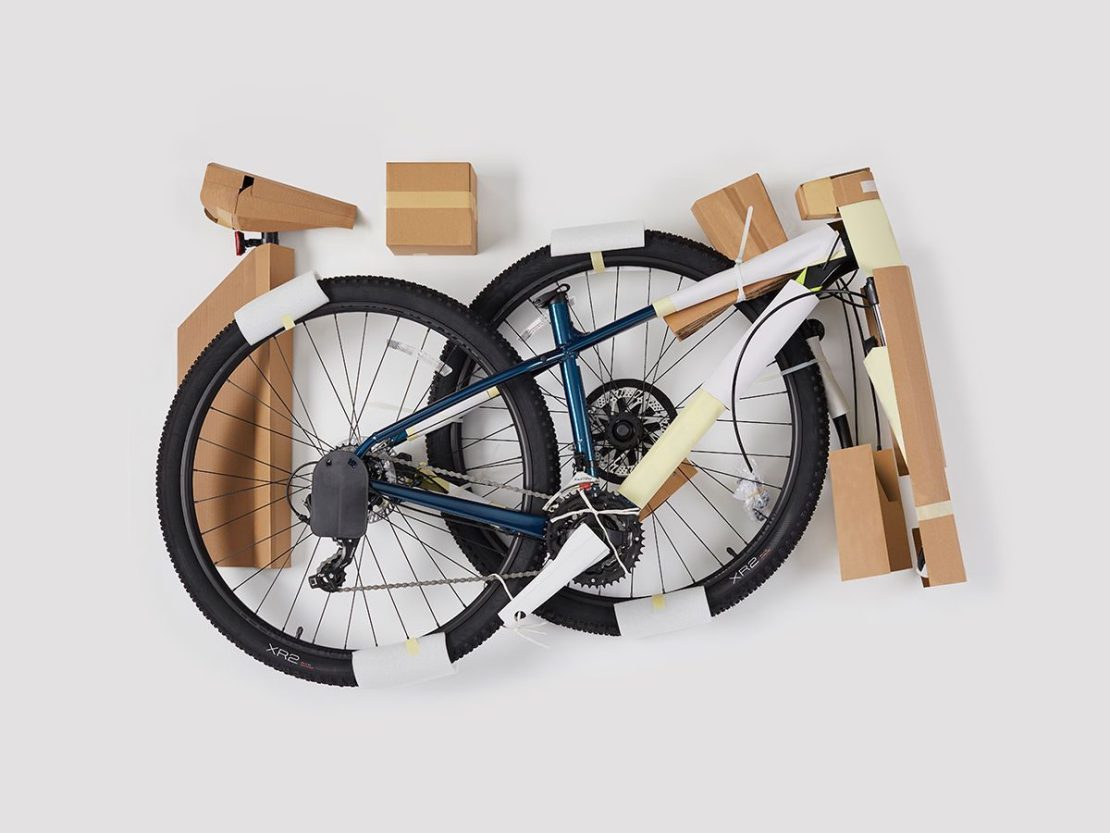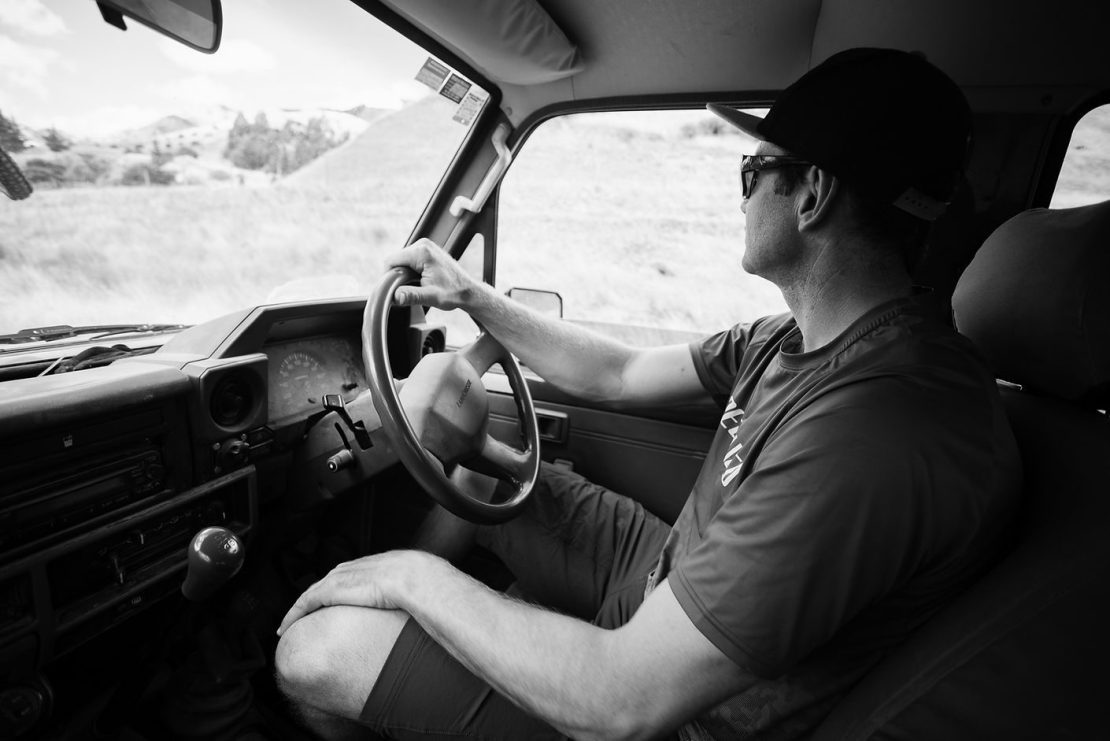News: Trek Releases Sustainability Report
In 2020, Trek Bicycle partnered with WAP Sustainability Consulting to conduct their first emissions audit to better understand their environmental impact and build a plan to become a more conscious and sustainable global citizen. The data takes into account a single year of operation pre-2020 as a baseline metric to identify the company’s areas of greatest impact to better determine where to dedicate attention and resources to reduce the carbon required to operate.

As a result, Trek defined 10 areas of focus to reduce their footprint including:
10. Reduce use of air freight – Air freight has 84 times the footprint of transport by ocean. As a result, Trek is improving supply-chain processes to reduce air freight mileage by 75% by 2024.
9. Consolidate shipments to retailers – To address ground delivery emissions, Trek is working on a global consolidated shipping strategy by 2024. Mainland European retailers currently utilise a batched shipping strategy that drastically cut mileage required to move product.
8. Increase reliance on renewable energy – By 2023, all Trek-owned facilities globally will be entirely powered by renewable energy. Currently, global headquarters uses of mix of 60.6% wind, 33.3% biogas and 6.1% solar power. The California and New Jersey distribution facilities are 100% renewably sourced.
7. Reduce corporate travel – In 2021, travel has been reduced by 50% of pre-pandemic levels and Trek will continue to reduce plane travel moving forwards.
6. Increase reliance on alternative materials – Trek is committed to using recycled, recyclable or refurbished materials to build products. Today, 15 products are made entirely of reclaimed materials. For example, in partnership with Bureo, a group working to remove discarded fishing nets from the oceans, Trek is grinding down this ocean pollutant into reusable material that is used to create the water bottle Bat Cages present on Trek bikes. The material is present in several handle grips as well.
5. Create zero-landfill manufacturing facilities – Trek’s goal is to become landfill-free by 2024 with efforts already in place in the US manufacturing facility.
4. Establish and protect new trails – Established in 2021, The Trek Foundation provides support to develop bicycle trails and infrastructure for public use and to protect land from development.
3. Remove plastic waste from packaging – Trek is using new packaging for bikes and accessories in an effort to cut down on non-recyclable pieces, working towards a goal of plastic-free packaging by 2024. In one year alone, Trek was able to remove 196,678 kg of plastic from packaging.
2. Increase access to bike share – Since 2009, Trek-owned bike share system,
BCycle, has reduced congestion and transportation-based carbon emissions in 35 cities.
Trek is committed to accelerating that growth and expansion moving forward.
1. Get more people on bikes – In the US alone, a 1% shift from vehicle transport to
cycling would result in a carbon reduction that is around 17 times bigger than Trek’s total
global carbon footprint. Trek is supporting causes that lobby for bikes, provide economic
incentive to cities and individuals to choose sustainable transport and build better bike
infrastructure.
Trek is continuing to encourage people to #GoByBike. The campaign, launched in
2020, has encouraged hundreds of thousands of riders to opt for travel by bike instead of
by car. To help provide riders with a new milestone, Trek calculated the Rule of 430 –
giving cyclists the opportunity to reach carbon neutrality. When you replace a ride in
your car or an emissions-emitting vehicle for a bike trip, you are making a small
contribution towards the carbon neutrality of your bike. If you ride a collective 430 miles
– or a little over a mile a day for a year – that you would have otherwise used a vehicle
for, you have saved the carbon equivalent of what it took for Trek to make your bike.
Anything above 430 miles, and your bike is now carbon negative.
To learn more about Trek’s sustainability efforts and to download the full report, visit https://www.trekbikes.com/us/en_US/sustainability/.
News: Pro Rider List Released for Crankworx Rotorua
Roturua, New Zealand, September 1, 2021: 19 months after it last wrapped, and 6 months after it was originally scheduled to run, the wait is nearly over. The Crankworx World Tour is set to make its triumphant return to its Southern Hemisphere home in Rotorua, November 1-7, 2021.
“I am frothing to be back in New Zealand!” said Vaea Verbeeck, the last woman to wear the Queen of Crankworx crown in 2019. “After being there in March 2020 last, the world turned into a much different place to navigate and Crankworx Rotorua was the last time we lived as per usual. I know it will still be different going back this time, but part of me feels like I’m going back to my happy place.”

"I'm super excited to head back to Rotorua, I always love being there and it somewhat feels like a home away from home for us,” said Bas van Steenbergen, who was in the lead for the King of Crankworx title coming out of the New Zealand festival in 2020. “I'm definitely feeling pretty confident having done well here in the past, so hopefully I can close out the King of Crankworx chase strong!"
“After some challenging times with travel I am really looking forward to getting back to NZ for Crankworx,” said Emil Johansson, who is currently in the points lead for the Crankworx FMBA Slopestyle World Championship title after winning in Innsbruck in June. The Swedish all-star has never clinched the overall, despite having won every event there is to win at this level of Slopestyle, including the Rotorua event the last time it ran. “I am going to try to do a run that I am happy with and up the run I did 2020.”
Other athletes on deck to wrap their competition season in New Zealand include:
On the hunt for the King and Queen crowns:
· Tim Bringer (FRA)
· Tomas Lemoine (FRA)
· Ed Masters (NZL)
· Bas van Steenbergen (CAN)
· Keegan Wright (NZL)
· Georgia Astle (CAN)
· Casey Brown (CAN)
· Danielle Beecroft (AUS)
· Harriet Burbidge-Smith (AUS)
· Robin Goomes (NZL)
· Kialani Hines (USA)
· Vaea Verbeeck (CAN)
Slopestyle’s Elite:
· Emil Johansson (SWE)
· Nicholi Rogatkin (USA)
· Erik Fedko (GER)
· Tim Bringer (FRA)
· Tomas Lemoine (FRA)
· Torquato Testa (ITA)
· Paul Couderc (FRA)
· Lucas Huppert (SUI)
· Jakub Vencl (CZE)
· Max Fredriksson (SWE)
· Lukas Knopf (GER)
· Tom Isted (GBR)
· Marcel Hunt (GBR)
· Griffin Paulson (CAN)
· Bernd Winkler (AUT) (ALT1)
· Lukas Schäfer (GER) (ALT2)
Top riders, keen to disrupt:
· Tuhoto Ariki-Pene (NZL)
· George Brannigan (NZL)
· Caroline Buchanan (AUS)
· Martha Gill (GBR)
· Mikey Haderer (USA)
· Brett Rheeder (CAN) (racing DH only!)
· Katy Winton (GBR)
The festival will include Pro, Amateur and CWNEXT racing, Kidsworx competitions, and a ticketed venue with all the action Crankworx fans know and love, bringing together the best of MTB for all kiwis to enjoy.

As Crankworx is included on a list of Government-approved events, only those critical to the event, including competing athletes, have been granted entry to the country by Immigration NZ.
With the border still closed to recreational travel, Crankworx Rotorua 2021 will provide a unique opportunity for kiwi fans to get front-row seats to all the action and watch the world’s best face off against their local heroes. From newcomers to keen riders, the event welcomes a wide range of people to get amongst the action and this year kiwis can get closer than ever.
Registration for all Pro, Amateur and CWNEXT events at Crankworx Rotorua is now open, running through October 27 at 11:59 p.m. NZDT: https://www.crankworx.com/athletes/locations/rotorua/info/
The full festival schedule is also now available: https://www.crankworx.com/rotorua/schedule/
Fans from around the world will be able to tune into live coverage of Crankworx Rotorua 2021 on Red Bull TV, including:
- Specialized Dual Slalom Rotorua
- CLIF Speed & Style Rotorua presented by Mons Royale
- Maxxis Slopestyle in Memory of McGazza
- RockShox Pump Track Rotorua presented by Torpedo7
- Crankworx Rotorua Downhill presented by Gull
Highlights and additional coverage will be available for:
- TREK Official Oceania Whip-Off Championships
- Crankworx Rotorua Air DH
The Crankworx Rotorua Slopestyle will be the final event of the Crankworx FMBA Slopestyle World Championship (SWC) season and will include the crowning of the Slopestyle World Champion. In addition, as the final event of the Crankworx World Tour season, Rotorua will be where the season’s overall King and Queen of Crankworx will be crowned.
With that, an additional piece of news was released today. Going forward, Crankworx Rotorua will shift permanently to the final stop of the Crankworx World Tour, closing out mountain bike competition season. The local Crankworx team are stoked to host the grand finale of the tour going forward and Rotorua makes the perfect hub for it.

Crankworx Rotorua Event Director Ariki Tibble explains: “While the Northern Hemisphere is wrapping competition season and gearing up for winter in late October and early November, New Zealand is in the thick of spring. The dirt is prime, the energy is high, and the appetite to get out and celebrate is on another level. To be able to bring all this together and share it with our international mountain bike family will be something special. While this year we can’t invite the world to celebrate with us in person to protect the health of New Zealanders, we are beyond thrilled to be able to host some of the world’s top athletes. We look forward to putting on a great show for our local crowds and for fans around the world on Red Bull TV in 2021, and to welcoming everyone back to New Zealand for Crankworx in 2022.”
“Coming back to Rotorua feels like we’re bookending a very strange chapter in our history,” said Crankworx Managing Director Darren Kinnaird. “Things were relatively normal the last time we were all together in New Zealand. The Crankworx World Tour was kicking off as usual in 2020. We had begun to hear whispers of COVID, but it wasn’t until the event wrapped and everyone got home that the world shut down. Since then, as event producers, we’ve had to draw on every ounce of creativity and tenacity that we have. While not always easy, it has paid off. Our athletes have been able to keep competing. The media are still out there shooting and sharing the stories of our sport – a sport that’s progressed at a rapid rate over the past year. And our fans have had something to look forward to and get excited about. Through it all, I am proud to say our team has never stopped pushing for what we believe in: creating opportunities, sharing our passion, celebrating the culture of mountain biking and the places steeped in the sport, and doing it all safely. I want to say a huge, heartfelt thank you to all those who were pushing and cheering alongside us over the past year and a half. We are here, preparing to wrap the final event of a full Crankworx World Tour in 2021, because of you. We’ve got some big things coming, and we can’t wait to share them.”
Get all the details of the 2021 Crankworx Rotorua finale (November 1-7) at crankworx.com/rotorua
Tickets are now on sale at https://www.crankworx.com/rotorua/passes/.
Video: Butters - Skip the gym & go Digging
In between guiding and instructing earlier this year I was lucky enough to be a trail builder on a new Grade 5 trail "Butters". This short film "Butters - Skip the gym & go digging" documents the trail crew experiences building this trail, located in the top of the South Island, Nelson, New Zealand. This trail has been named and built-in memory of Bernard “Butters” Simmonds.
The Trail was co-funded by Santa Cruz Bicycles Pay Dirt fund and Nelson City Council. Special thanks goes to Nelson Mountain bike Club and Ngati Koata trust
It was a real privileged to work alongside such experienced trail builders. Easy trail building services, Ian Phillipps, Martin Strelka, Kurt Lancaster, Digby Shaw and Niklas Louis Hueber
Release: Bosch's 2022 Smart System
Fully connected: The smart system
The interplay of app and eBike components enables an individual eBike experience
-
Riding enjoyment through digitalisation on a new level; in everyday life and in leisure time
-
Thanks to the eBike Flow app, the smart system connects perfectly coordinated components with the digital world
-
The eBike system can also be controlled without an additional display using the LED remote control unit
-
Extended range thanks to the PowerTube 750
-
In the future, many eBikes with the smart system can be retrofitted with the ConnectModule and will be further protected against theft
The smart system by Bosch eBike Systems - consisting of the new eBike Flow app, control unit, display, battery, and drive unit - ensures an individual eBike experience. The new system generation combines technologically high-quality eBike components with the digital world, taking riding enjoyment in everyday life and in leisure time to the next level. “Digital features and services enrich the pedelec experience and are important enablers for our mobile future in a connected world. With the smart system, we are taking another step towards the eBike mobility of tomorrow,” says Claus Fleischer, CEO of Bosch eBike Systems.
An overview of the smart system:
Smart, forward-looking and customisable: The eBike Flow app
Download to discover a uniquely connected experience. The eBike Flow app is the central connection to the eBike and the key to the connected biking experience. Over-the-air updates always keep the eBike up to date and continuously enhance the eBike experience with new, innovative features. The app lets you customise riding modes, record activities completely automatically, and integrate fitness apps such as Apple Health.
Intuitive, innovative, ergonomic: The LED Remote control unit
A fully connected control centre that’s fun to use. The LED Remote can be operated easily, comfortably and intuitively with the thumb. Using different colours, the LEDs indicate the respective riding mode, which is easy to recognise while riding. Also practical for those who want to be on the road without a display when eBiking: The LED Remote is sufficient to control the eBike system and displays the most important information about the eBike, such as the current charge status and support level. The LED Remote is connected with the eBike Flow app via Bluetooth and thus the Internet.
Stylish, robust, clear: The Kiox 300 display
The robust companion on sporty rides. The Kiox 300 display provides a clean eBike look on the handlebar and is easy to read in any riding situation. With the display, all relevant fitness data can be displayed to optimise your training. Through regular 'over the air' updates, Kiox 300 always stays current and thus promises a lot of fun on sporty rides or on the trail, including in the future. The buttonless colour display is controlled via the LED Remote and is connected to the eBike Flow app. Using the display holder, Kiox 300 can be ideally positioned on the handlebar according to the rider's preference.
Enduring, elegant, reliable: The PowerTube 750 battery
The new flagship rechargeable battery for long and challenging rides. The PowerTube 750 offers the maximum range in the current Bosch eBike battery portfolio and is optimally designed for many metres of climbing and even longer distances. The lithium-ion battery can be integrated into the eBike frame and is characterised by a particularly high energy density at a weight of approx. 4.4 kilograms. The PowerTube 750 can be charged to 50% in just over two hours and fully in about six hours using the 4A Charger.
Powerful, dynamic, individual: The Performance Line CX drive unit
The powerhouse among the drives. The powerful Performance Line CX drive unit provides maximum 85 Nm of torque for a natural, dynamic and unique riding experience. In the eBike Flow app, the strength of the support, dynamics, maximum speed and maximum torque can be individually set for the respective riding modes and thus perfectly adapted to your own riding style.
A glimpse into the future: Future optimisation with the ConnectModule
In the future, eBikers will also be able to benefit from further developments in the area of theft protection. eBike models that are ConnectModule ready can be retrofitted with the ConnectModule in the future. This means, for example, that the eBike can trigger an acoustic alarm to deter thieves and, in the event of theft, be tracked in the eBike Flow app. In addition, further functions will follow that can be used with the ConnectModule.
Release: Bontrager Rapid Hydro Pack
The beloved Rapid Pack made better. A larger rear pocket that more easily holds a shock or mini pump and an integrated bladder for even more hydration.

• Larger rear pocket
• Integrated hydration bladder for easy access while riding
• Secure magnetic retention for hydration hose
• Light weight stretch woven material with elastic strap
• Foam back panel for breathability and comfort
• Internal compartments for easy organization
• Middle water bottle pocket centralizes weight while riding
• Right side features compression phone sleeve and key fob
1.5 L Hydration Bladder
Integrated Hydration Bladder adds 1.5L of easy access hydration with a HydraPak bladder and dedicated zippered pocket to securely hold it.
Magnet Magic
Magnets securely hold bite valve in place to it is out of the way while riding but so very close when thirsty.

Carry More
Additional capacity lets you carry more. The larger back pocket holds the HydraPak hydration Bladder and so much more, integrated pump loops make it easy to stash a mini pump or shock pump in addition to 1.5L of hydration
Comfortable Cargo
Forgiving elastic materials, perfectly balanced pockets, and an adjustable belt all add up to hip pack that stows everything you need yet quickly disappears as you start riding.
Centralized Water Bottle Pocket
A secure pocket holds a water bottle in the center of your back to prevent it from swaying back and forth while a pull loop makes grabbing and storing your bottle a breeze.
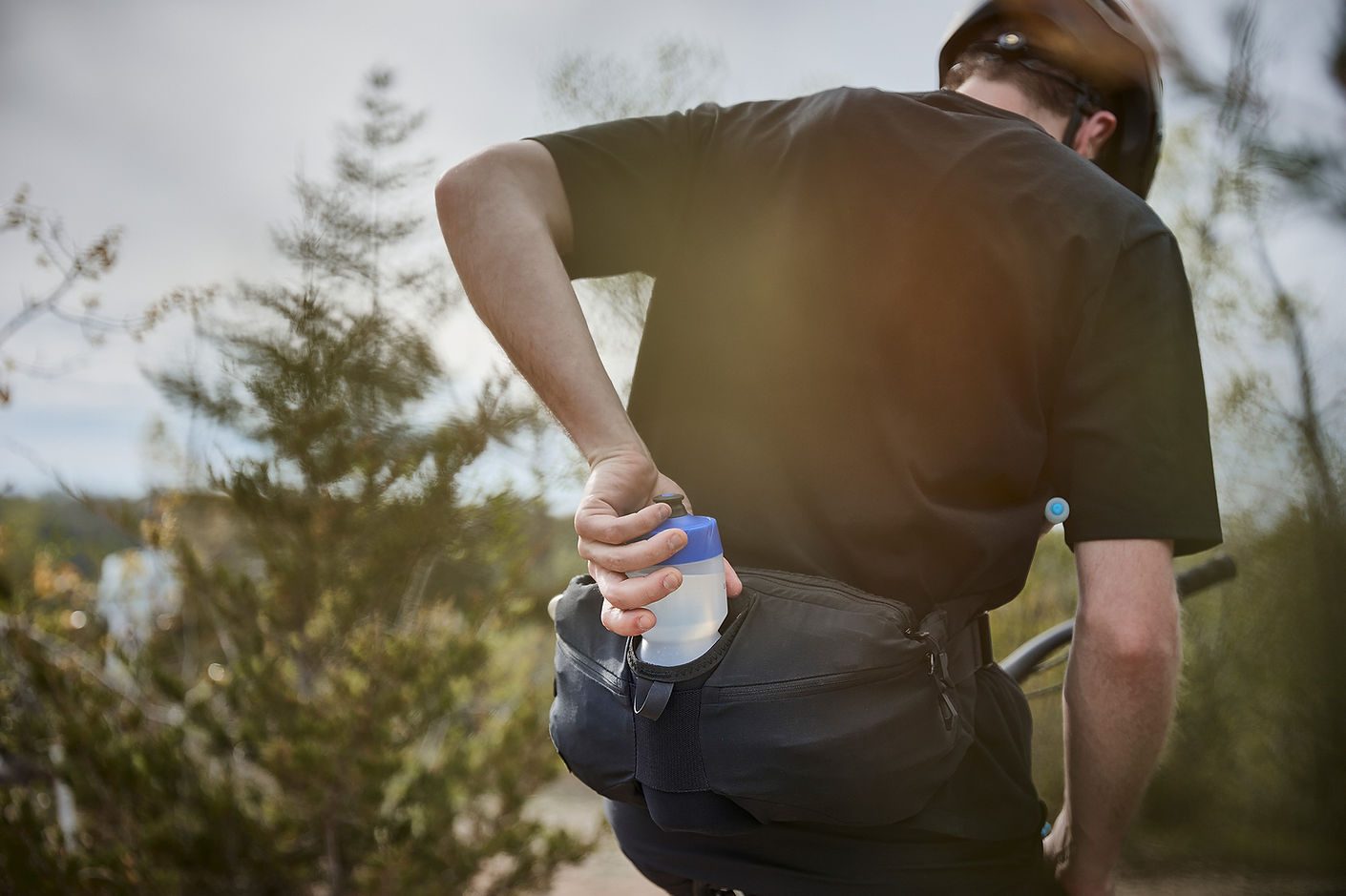
Organized Internal Pockets
The zippered pocket includes internal mesh pockets, perfect for all your ride and life essentials – tube, repair kit, multi tool, keys, phone, snacks. Keep it all secure and organized.
Ready to Ride
Be ready at a moments notice with a bag that has all of your ride essentials together and ready for even last minute rides. Never not be ready.
Release: All-new SRAM HS2 Rotor
The all new HS2 Rotor is a mountain bike specific rotor designed to improve brake performance while reducing noise and increasing heat dissipation. Featuring a new brake track pattern for increased pad traction and recessed spokes with thermal dissipating paint, the HS2 is a more powerful, quieter rotor with best-in-class heat management.

• Thicker 2.00mm rotor
• Superior heat management (40°C less than Centerline, per Garda test)
• 7% more power
• Available in 6 bolt and Centerlock
• MTB specific
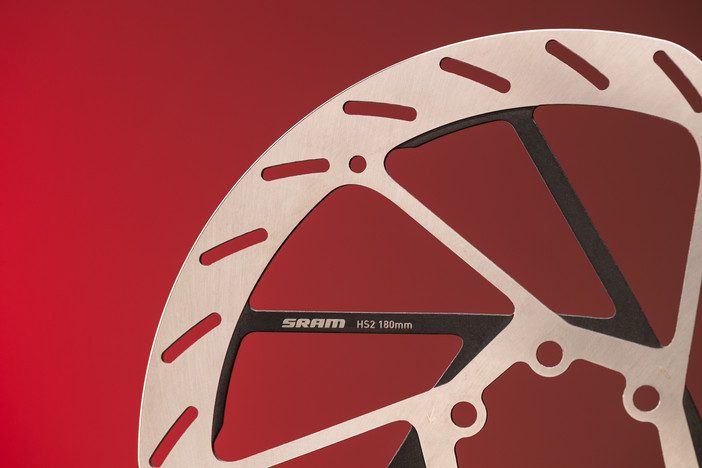

Video: Girl Meets Bikes
Leah Lind-White gives in to temptation while she waits for the bus to go home after work. Steel, sleek, and extra slack, the Honzo ESD is irresistible. Leah hops on board for a night of pure adventure with the ESD. As the sun rises and the work day approaches, Leah accidentally drops her shoe in a mad dash to make it to her train on time. Fortunately, fairy tale chivalry is alive and well, and the ESD is waiting for her at the station at the end of the day, ready to whisk her away on their next adventure.
If Mad Max rode a bike, it would be the Honzo ESD. It’s part Honzo, part monster, and with geometry that inspired the Process X, it’s made for those who want to punish the trails. A steel frame holds a Marzocchi Bomber Z1 fork with 150mm of travel. It’s got strong 4-piston brakes, grippy Maxxis rubber, and a headtube badge that will scare your children at night. This is the Warrior of the Wasteland.
Release: New PRO Bike Tools
Want the pro-rider aesthetic of a clean looking bike, but still want to take the essentials with you? Then the new PRO Smart Cage is the answer to your upgrading dreams. And if you’re wondering what to put in the smart cage, new tools are just the ticket. Plus, we have a new pocket-sized tool for routing internal hoses, cables and Di2 wires.

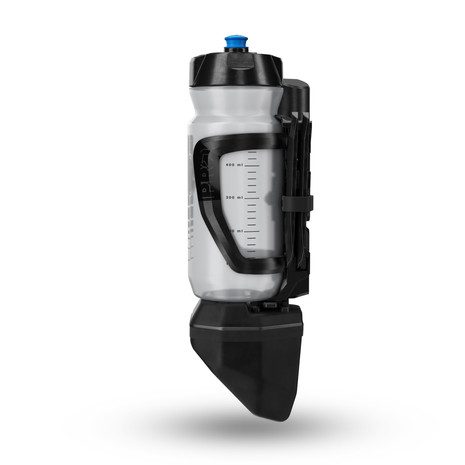

Smart Bottle Cage
The new PRO Smart Bottle Cage (PRBC0049) combines an adjustable bottle cage with an integrated storage solution. It offers universal bicycle frame compatibility with adjustability in the height and direction of bottle pull. Selected PRO mini tools can slot into the base of the Smart Bottle Cage, sitting behind the bottle, while a mini pump or a CO2 cartridge can be strapped to one side of the cage and two tyre levers can be strapped to the other. A clip-on PRO Storage Pouch can be added below the Smart Bottle Cage to house a spare tube and other small puncture repair accessories.
Workshop items
In PRO’s new tools for 2022 comes 12-speed tools, handy for those new groupsets you’re lusting after, and an internal cable routing tool with compatibility for Shimano’s new EW-SD300-I and EW-SD50 wires.
Four new tools are compatible with PRO’s Smart cage – the PRO Performance 9-Function, 9-Function Tubeless, 13-Function and 17-Function Mini Tool (PRTL0123, PRTL0130, PRTL0131 and PRTL0132) – which allows the tools to slot it into the cage’s housing bracket, so you can forget about it until you need it.
Each tool has a compact design with Allen and Torx keys, and the tubeless tool also includes a reamer tool, tyre plug and a tubeless puncture plug insertion tool. Each bit on the mini tools feature hardened steel tips, for precise adjustments and to ensure the longevity of the multitool.

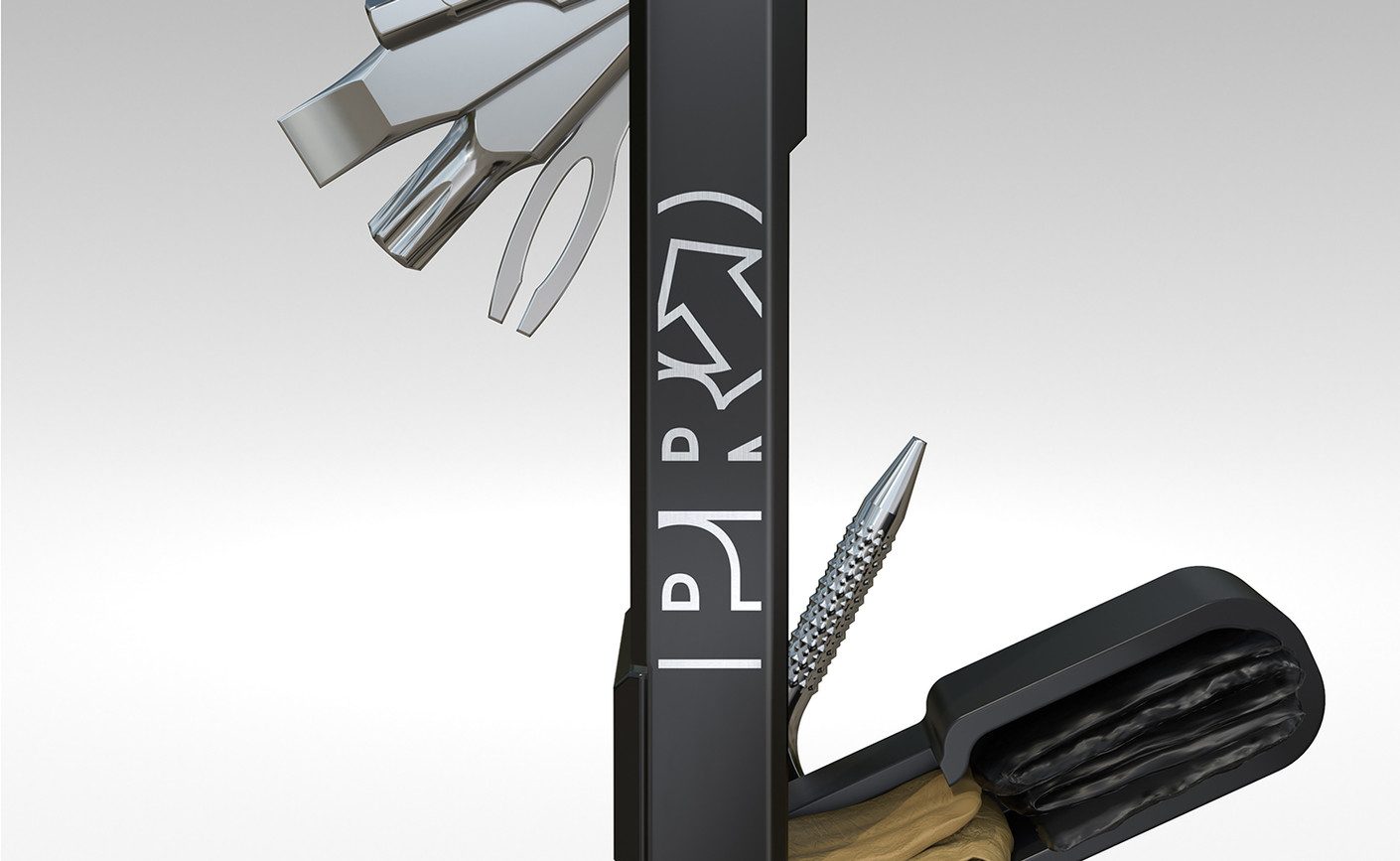


At the elite end of the range are PRO’s new Team 20-function (PRTL0134) and 22-function (PRTL0133) mini tools. Developed to repair most mid-ride mechanicals these compact, ultra-lightweight and versatile tools feature 12-speed compatible chain tools and a CO2 regulator. Functions include tyre levers and all the steel-hardened Allen, Torx, screwdriver and spoke wrench keys you are likely to need when repairing a mid-ride mechanical. It also boasts a 12-speed compatible chain tool and an integrated tyre lever.
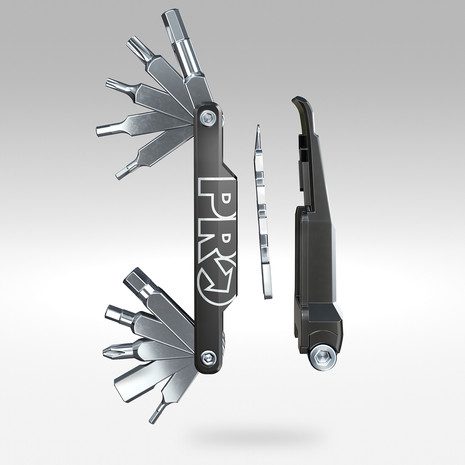
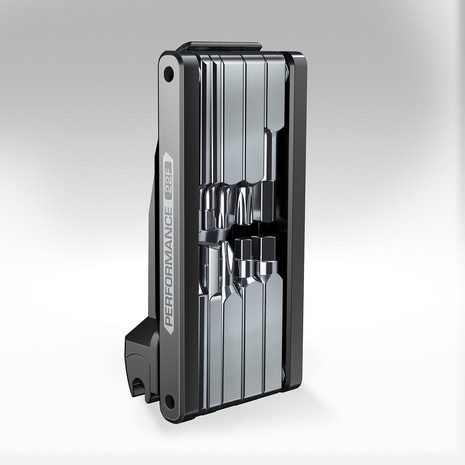

Completing the introduction of new tools, the new PRO Internal Routing Tool (PRTL0150) is compatible with Shimano's new EW-SD300-I Di2 wires and EW-SD50 wires, as well as mechanical shift cables and hydraulic brake hoses. It comes in a durable aluminium construction with a protective storage pouch.



Finally, the new PRO Bike Wall Mount Sport edition (PRAC0237) is a stylish and effective way to store your bicycles at home or in the workshop. The pedal hook and dual wheel cradle design allows you to mount your bike horizontally, at a slight angle, on a wall and store other bikes above or below it. The Bike Wall Mount Sport is universally compatible with all bicycle types, including E-Bikes.
Whichever direction you choose, PRO’s new tool and workshop solutions will allow you to upgrade and outperform in 2022.
Story: Life according to Justin Leov
Life happens at a million miles an hour for Justin Leov. In that respect, not a lot has changed since his days racing the World Cup downhill circuit. The day we meet, he bowls up to the airport pickup zone, chucks the window down, then leans out and asks if I’m Liam. I reply, ‘yep’, so he leaps out and gives me a stern handshake - you get a lot of these in the south. Justin hails from Blenheim, which is at the top of the South Island, New Zealand. We throw my bags in the back of his pickup and head to his digs.

During this short ride, we cover most riding topics - and give the president of the local mountain bike club a call. I get the gist that Justin is always ‘on’ – his hustle is relentless. Our chat is mostly about bikes – and rightly so, as he’s made a bloody decent career out of racing them. But, more on that shortly. Justin’s stories, and his ability to relay them like they happened yesterday, is incredible. I scramble to take notes or record some of what he is saying, as we leap from topic to topic. Being in his company, you get a real sense of Justin’s energy and enthusiasm for the sport, and immediately I can see why he’s done so well.
After traversing some dry and dusty gravel roads, we pull into Justin’s property, Jentree. There’s a country-style house, a barn, a river, and a steep hill that sits behind the house. We jump out of the pickup in front of the barn, which is littered with property maintenance gear, bike paraphernalia and the old-school Land Cruiser he uses for shuttles up his hill. The race plates from his racing days are scattered all around and there’s even a wall dedicated to them. From Downhill, EWS and Crankworx, there’s either a race plate, medal, trophy or cheque (you know, those large, novelty ones). It’s evident Justin has excelled in his chosen sport, and I’m blown away by how much mountain biking history is encased within his barn.


Justin is pro eMTB, and rides a Specialized Levo SL. Yes, he does have a pedal bike too, a Specialized Enduro, but these days most of his time is spent on the Levo SL. Justin reckons eMTBs have definitely established a place in the market. His Jentree property is straight up, so the Levo SL makes the climbs more fun and, when Justin gets home from his job as a builder, he can cut laps without anyone else having to shuttle him. What’s more, he can ride the descents swiftly, too. Of course, knowing a thing or two about racing downhill bikes helps, along with knowing trails on his property, but Justin explains that the Levo is much more planted on the trail, due to it being a little heavier. Put simply, it gets your centre of gravity a little lower.
“For me, the Levo SL is nearly the perfect bike,” Justin elaborates. “Being time limited with work, kids and trail maintenance, it simply means that when I can get out, I get twice as many laps in on the trails than when I’m on my regular bike. Being a lot lighter than the regular Levo, I find the dynamics while riding the Sl to be very similar to a regular bike (more playful and easier to manoeuvre). This, I believe, suits the rider who likes more technical trails and wants to ride with a feeling closer to their regular bike, yet also wants to get a whole heap more riding in for their time. I’d also like to add that my riding intensity doesn’t change, I still go flat out on the climbs like I have always done, it’s just that now I get there quicker.”




Justin spins some great yarns, but the conversation never wanders too far from his racing days. Of course, this is what I’m here to cover, but I could definitely spend more time just hanging out with him. He’s a top bloke who is also very humble, especially when you consider that his past is more decorated than most.
Let’s kick things off at the beginning, when he was first getting into riding, as a youngster. Mountain biking wasn’t on his radar initially; he was into motocross, but after some pretty heavy injuries, he moved away from it. It was at high school, Marlborough Boys College, where Justin was encouraged to give mountain biking a go. The youngsters would head out each Wednesday and explore the region’s trails and, on a few occasions, they headed to Jentree. There were a few groms who were keen riders, and they pushed each other – together, they headed off to races and events and started kicking ass.
Justin kept up the training and would ride from his place, across to Jentree (where he now lives), and cut laps until the evening light ran out. This was his daily routine: just getting his skills up and riding as much as he could. At 14, he entered his first Nationals on the West Coast. The hard, gnarly and technical track didn’t put him off and, after this race, he was hooked. As he started to race more, his skills improved and he took his first Junior National title at Jentree in the coming years. Oceania Champs followed, and soon Justin had hustled some businesses around Blenheim to support a trip to Europe: the good folk of the region backed him, and off he went. The plan was to hit the ground running with the World Champs and World Cup finals. Long travel and hectic schedules didn’t distract Justin at the World Champs in Kaprun, Austria, where he was 10th overall (racing as a junior) in his qualifying run, with a stacked field, and 20th in his race run. A week later, he was racing in Les Gets, France in the Open Men’s field (back then there wasn’t a junior class) throwing solid runs and placing well in the qualifier to eventually end up 40th in his race run. Justin returned home, but was yearning to head back again. The very next year, he did just that.

The plan was super loose, but Justin was determined to make it. Alpe d’Huez stands out for him that season, not only because he wore a skinsuit and placed 9th overall, but because he met Jason Marsh, a Kiwi living in Morzine who was hunting for different ways to do things (he would go on to work as Greg Minnaar’s mechanic and create MarshGuard fenders). At 17, Justin was still trying to work out what made him tick. Building anger before races was discovered by Marshy (Jason Marsh): he started annoying Justin before his run, and it worked. Being pissed off and getting aggressive before races made Justin ride harder. Justin recalls a time later on in his career, when he asked SRAM for a new derailleur and they wouldn’t help out. This fuelled his anger and was part of his process. “Everyone has their things, but learning this helped me early on. Also, work rate means a lot and you’ve got to have the want and desire. You’ve got to have the mongrel. Sometimes natural talent will be taken away by hard work,” Justin explains.

From showering in a bike wash, to sleeping in vans and doing just about whatever it took to get from race to race in Europe, built Justin’s character for the years to come. By 2005, he was riding for a small Swiss team, called the Suspension Centre Team, owned by Gery Peyer. It wasn’t a salaried position, but Gery gave Justin a place to stay as well as transport and a Turner to race on. This was the year Justin made himself known on the world stage, placing on the podium in USA and rounding out the year in 15th overall. After this, he started getting noticed, and signed with Martin Whiteley as a manager. Martin helped land a deal with Yeti for Justin’s 2006 season. The enthusiasm and stoke of making it was there but, unfortunately, it was short lived, with an injured shoulder during a 4X gate start in Spain, where he didn’t understand what the medical staff were saying. He punched on for the rest of the season before eventually getting surgery when he returned back home. The following seasons were much better and Justin snagged 10th overall finish in 2008. Martin then asked Justin to join a few team; Trek World Racing, with the likes of Tracy Moseley and Aaron Gwin. This was a well-oiled and organised programme. “You need to figure out what you need to do win – a lot of kiwis did well at home, but struggled with the stress abroad.”
After a few years riding at the highest level in downhill, Justin’s enthusiasm for it dwindled. The demands were high from constant training, intense races (with no room for error), hectic travel schedules and the stress of it all. He felt burnt out, threw in the towel and retired in 2012. Finished with racing, Justin returned home to start a building apprenticeship.
But, as it so often does, racing bikes soon lured him back in.
There was a new discipline on the scene: enduro. Justin was happy at home; he was completing his building apprenticeship and had been off the bike for a while, when Martin called and (eventually) convinced Justin to give this enduro racing a go. Relenting, Justin flew back abroad and, sure enough, finished 4th in his first race: that was enough to hook him. Shortly after that, Trek Factory Racing offered him a deal where he could race enduro and help out trackside with downhill rounds. It meant he’d be up at 5am training for himself, then helping out on the downhill racers, followed by a gym session in the evening. It’s not hard to imagine how this got a little too busy after a while, and Justin felt he couldn’t give it his all, so the following season he scaled back and focused solely on racing.
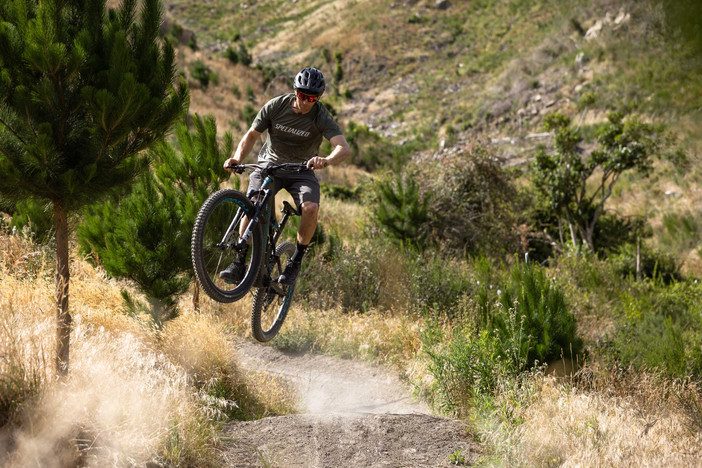
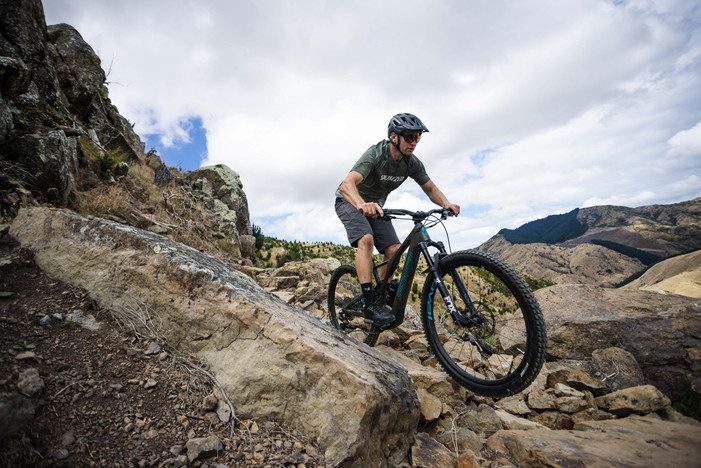


Justin says these were some of the best years of his racing career, on reflection. He had a great relationship racing with Tracy Moseley and there was great support with the team. The Trek engineers were also so invested in developing the best product for racing; they would use rider feedback as much as possible, and Justin and Tracy were behind the 29er movement before it was widely popular. They helped develop the Remedy 29er and the Slash 29er. And his racing? It was going really well, especially aboard the Remedy 29er - he took third overall in the 2014 EWS. That same year, Tracey won it. The next year, Justin’s focus was on taking the win. He won his first EWS round in Scotland and held the lead with the series but, luck wasn’t on his side when he crashed in Whistler, dislocating his shoulder.
There’s no doubt Trek were a massive part of Justin’s career, and it was hard for him to move away from the team. However, when you’re a sponsored athlete, the window of being able to earn highly is only open a short time. After some serious consideration, Justin signed with Canyon in 2016. Trek had the opportunity to match what Canyon offered, but couldn’t, and told Justin it was too good to turn down. He still had the mongrel and fight but, on the first Canyon training camp, he caught glandular fever. In order to fully recover he needed to return home and be off the bike - for at least six weeks. The first few weeks, Justin could barely make it off the couch, a concept which was not only hard physically, but mentally too. The next few years didn’t go his way, due to health reasons and Canyon not moving with the times in regards to having a 29er race bike option. The time came to retire, again, and head home to complete the building apprenticeship - Justin was fed up with the bike. “Reflecting on my career, everyone is driven differently. For me, I was focused on racing and missed most of the social occasions. You have to give it 100%. Find where you are – you can try and change yourself to fit a model, but you’ve got to see what’s best for you.”
Justin was back on the tools, building and living in Blenheim, when he caught wind that the Jentree property was for sale. This was enough to ignite his passion for riding bikes again. Justin, his wife Victoria and their two kids, Annabella and Luca, moved in.
“Jentree got its name from the previous owners, John and Jenny Meek. John was referred to as ‘Track Man John’, and was the creator of the cross country course. When Victoria and I bought it off them, we decided to keep the name as a tribute to John and Jenny’s hard work. The original cross country was, at the time, more technical than most other courses, so it developed that reputation. My first ever mountain bike race was an XC here, and it had a climb so steep you had to shoulder your bike and climb up it by foot. It was so cool to see something like that in a course, you don’t really see that often anymore. John loved naming sections and locations; the DH was called The Mangler, true to its name it also delivered. Digger-built trail didn’t really exist at this time, so the closest we had was my dad pushing a few cuts in the hill with a bulldozer. These would be named “Leov Lane”, and the pond at the top of the hill was also built by my old man and named Gladys’ Pond - after John’s mother. There were definitely a few degrees of connection to this property for me, and being able to purchase it from John and Jenny really brought it back full circle.”
The place needed a bit of work, and the trails had been left for years, but Justin just chipped away on things at a slower pace. Justin takes pride in the property, and the Jentree trails are unique. It’s clear to see that there’s plenty on for Justin these days, but he gives me ample amounts of his time. Heck, we even stop at one point when we’re shuttling the trails so he can offer me some skills coaching. Yep, he coaches mountain bike skills too – well, there’s not much he doesn’t do! The tips he gave me have made my riding a whole lot better, and I’ll be giving him a call again for sure.

Justin’s wife, Victoria, welcomes me into their family home and I quickly learn that she’s his most dedicated supporter and has been by his side throughout his whole career. It’s clear to see that Justin’s performance at the highest level has been backed by Victoria holding things down on the home front and, importantly, keeping things balanced. Of course, there’s been some rocky moments, but Justin says they’ve learnt over the years: it’s not easy when you’re pro, often miles from home, focusing on riding bikes - sometimes there’s not much room for anything else. For Justin and Victoria, years of phone calls progressed to Skype calls and seeing how best to work a long distance relationship.
It takes one hell of a driven person to pursue a sports career at the highest level and, without doubt, Justin is one of them. But, his humbleness remains, even after being one of our most decorated mountain bike riders. It’s clear to see the lessons learnt from racing abroad are applied to many aspects of his current life. His support network is solid and his passion for the sport, and giving back to the next generation, is what stands out.
Words: Liam Friary
Images: Henry Jaine
News: Reece Wilson's 2021 World Champs Trek Session
+World Championships is a special time, the one time a year when riders swap team colors for flying national pride on their backs. Custom-painted helmets and bikes celebrate culture and ancestry. Normal rules no longer apply.
Part of the tradition is the bike build – a ritual almost always held the week of the big race, as if to keep the rider in suspense, but almost certainly to keep the bike clean before hitting the track.
There’s a special energy surrounding these buildouts, with the mechanics applying the pinnacle of their care and attention to a bike that may only tackle a handful of downhill runs. Applying the perfect amount of grease where necessary (removing it in others), knowing the subtle difference a millimeter here or there can make, and jeweling it with anodized titanium bolts. This is their craft. Combined with the art of the painters, you have a steed as unique as the rider who will hopefully be inspired by the extra boost of confidence such a bike can bring.
Reece Wilson is the reigning DH World Champion, and while he won’t be wearing the rainbow stripes when the clock starts ticking, he has roughly four minutes to earn the right to put them back on. Reece will be racing aboard his custom white chroma Session that his mechanic Joe Krejbich and Trek Factory Racing have meticulously assembled. His build features a SRAM X01 DH drivetrain, SRAM Code RSC brakes with 220mm rotors front to back, and RockShox BlackBox suspension to tame Val di Sole’s notorious course. A Bontrager wheelset, and Title cockpit round out the bike built for a King."


